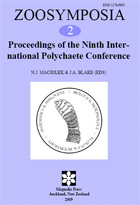Abstract
A new commensal species of Polydora was found associated with hermit crabs from shallow subtidal coral reefs in Jamaica, West Indies, in 2005 and 2006. Polydora nanomon sp. nov. is the third known obligate commensal polydorid of hermit crabs. The species is found in approximately 20% of the gastropod shells, most commonly Leucozonia nassa leucozonalis (Lamarck, 1822), inhabited by Calcinus tibicen (Herbst, 1791) and other hermit crab hosts. P. nanomon sp. nov. produces a hole in the apex of the shell, enters the lumen of the uppermost whorl, and connects to the columella with a tube of mucus and detritus. One large female (up to 70 setigers) is found in the apex with up to four smaller males (generally <30 setigers). Females are distinguished from other species of Polydora by the morphology of the major spines of setiger 5. In addition to a horizontal row of major spines with two lateral teeth, companion setae, and ventral capillaries, setiger 5 contains a group of superior accessory spines, including one large falcate spine with a channel extending down the shaft, one spine with a low rounded tooth, and one companion seta. P. nanomon sp. nov. exhibits sexual dimorphism with the males being much smaller than females, having a reduced first segment, and lacking accessory spines on setiger 4 (= setiger 5 on females). The occurrence of sexual dimorphism within the family Spionidae is reviewed.

